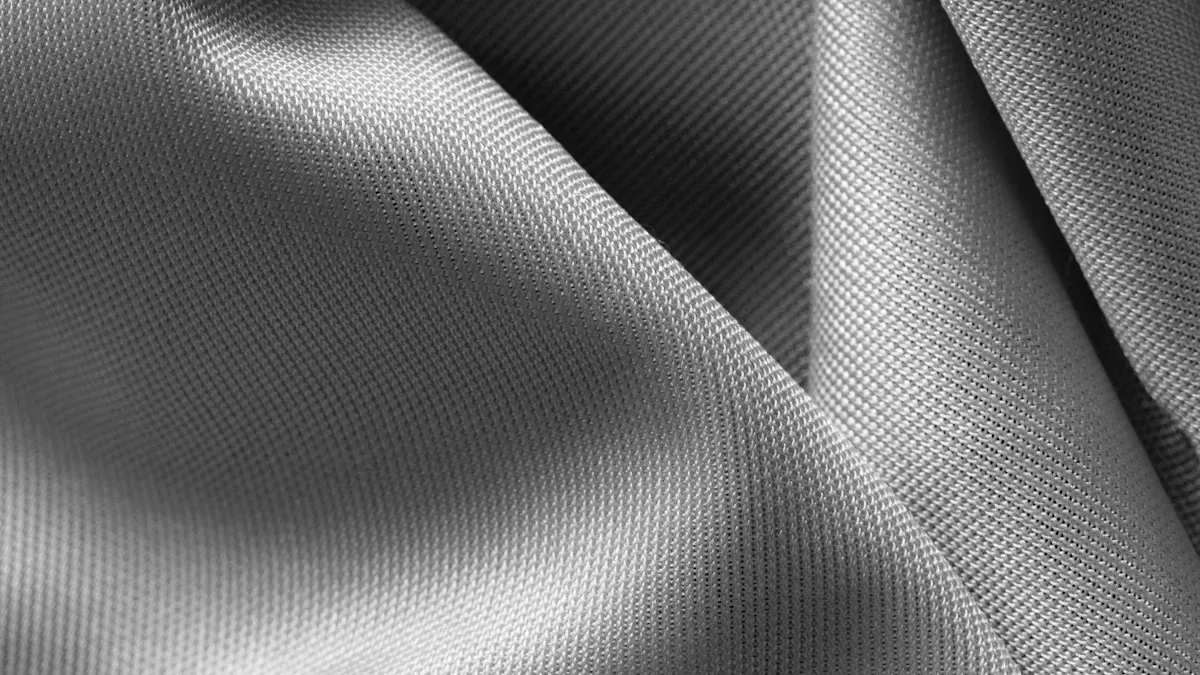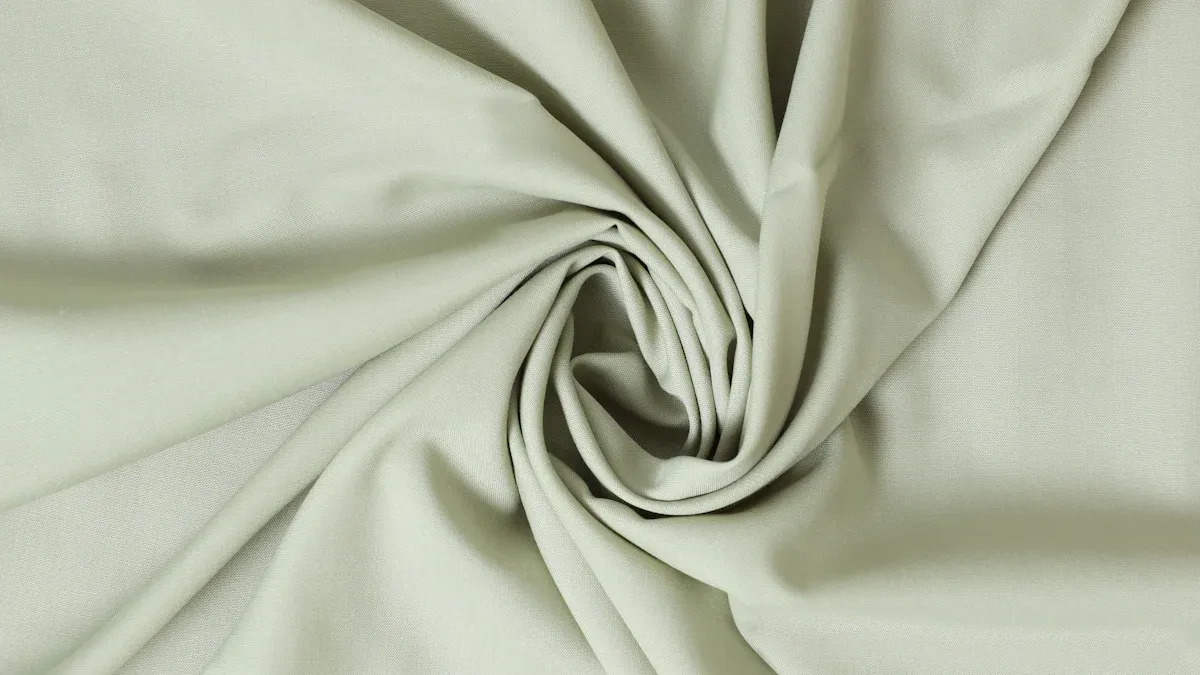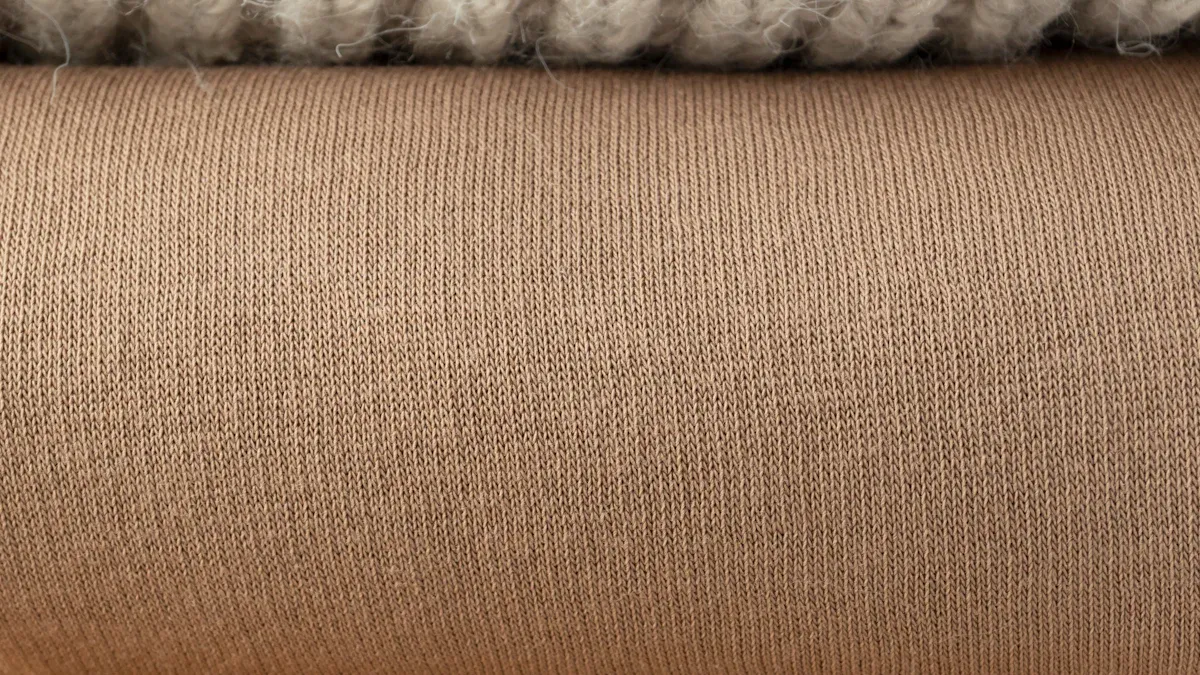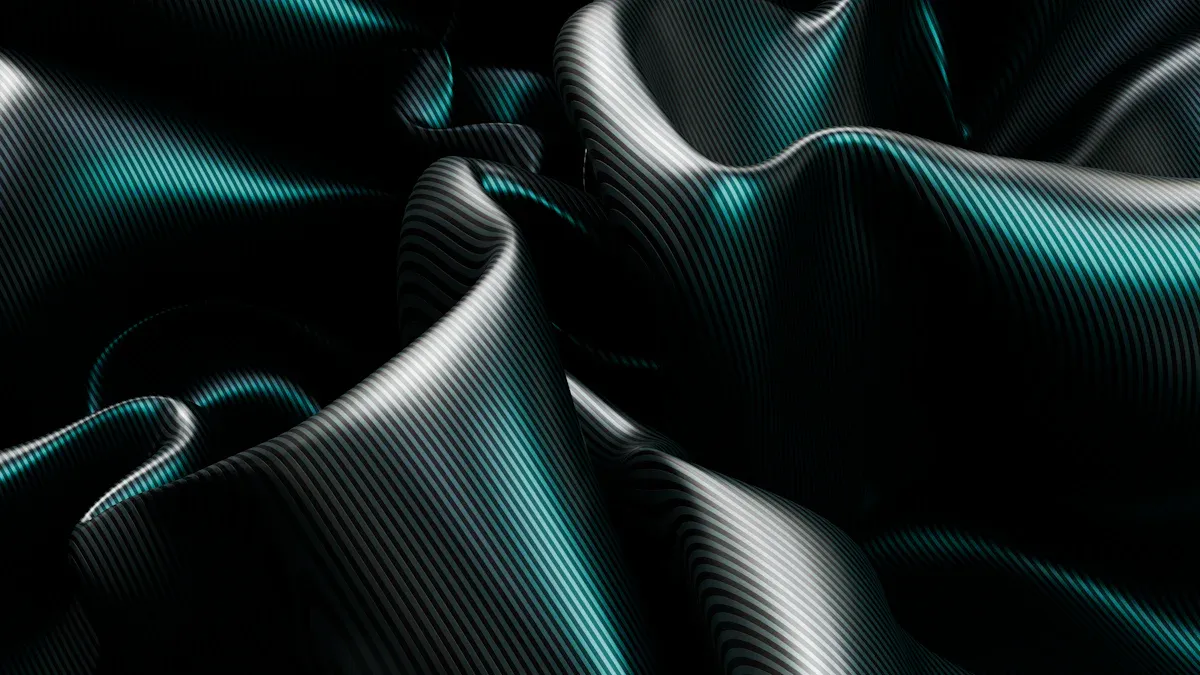
Scuba fabric is used in fashion and other industries because it has special features. Designers like its thickness and how much it can stretch. It can stretch up to 300% and still keep water out. The fabric feels firm and holds its shape well. It does not let water in because it has tightly woven layers. It also has tiny holes called micro-porous membranes. These holes are as small as 0.03 μm. Many people use scuba fabric for tight clothes, jackets, swimwear, sportswear, accessories, and even things for the home.
Property Description & Quantification Thickness About 10 μm for hydrophilic membranes Stretch Can stretch up to 300% while staying waterproof Water Resistance Withstands water pressure of 1039 mm, windproof, and prevents liquid water penetration Structure Micro-porous membranes and dense weaves control permeability and maintain shape
Key Takeaways
- Scuba fabric is thick and stretchy. It does not let water in. This makes it great for clothes that need to keep their shape and stay dry.
- Designers use scuba fabric for many things. They make dresses, jackets, swimwear, and accessories with it. The fabric looks smooth and feels nice to wear.
- People also like this fabric for home decor and some work products. It lasts a long time and is easy to take care of.
- Scuba fabric is lighter than neoprene. It is also more bendy. This makes it better for daily clothes and tight outfits.
- To keep scuba fabric looking good, wash it gently in cold water. Dry it with care. Do not use strong cleaners or rough washing.
Scuba Fabric Overview
What Is Scuba Fabric
Scuba fabric is a modern textile. It is used in fashion and technical fields. Italian Artisan says it is synthetic and stretchy. It is made with double-knit construction. The fabric feels smooth and a bit spongy. It is thick and helps clothes look crisp and shaped. Suerte Textile says the name comes from “scuba diving.” This is because it is like wetsuit material. Makers use polyester, nylon, and elastane to make it. The fabric has two layers and is flexible. It gives a smooth look and holds its shape. Scuba fabric first showed up in the early 2000s. It was made as a lighter and more flexible choice than neoprene. It became popular fast in fashion and sportswear. People liked its mix of structure and comfort.
Note: Scuba fabric is not the same as neoprene. They are similar, but scuba fabric is lighter. It is better for daily clothes.
Key Properties
Scuba fabric has many important features. These make it popular in many fields:
- Thickness: The fabric is usually 2-4 mm thick. This gives it structure and a smooth look.
- Stretch: It has a lot of elastane. It can stretch up to 300%. This makes it good for tight clothes.
- Water Resistance: The tight weave and synthetic fibers keep water out. This helps keep you dry.
- Structure: The double-knit build makes the fabric firm. It helps clothes keep their shape.
- Comfort: The fabric feels soft and spongy on your skin.
- Durability: It does not wrinkle or wear out easily. This makes it good for using many times.
A table below shows these features:
| Property | Description |
|---|---|
| Thickness | 2-4 mm, gives structure |
| Stretch | Up to 300%, makes it flexible |
| Water Resistance | Keeps water out, keeps you dry |
| Structure | Double-knit, keeps its shape |
| Comfort | Soft and spongy feel |
| Durability | Does not wrinkle or wear out fast |
Fashion Uses
Apparel
Designers pick scuba fabric for fitted clothes like dresses and pants. The fabric stretches and keeps its shape well. This helps clothes look neat and sharp. Many brands use it for tunics, suits, and uniforms. The material fits close to the body but feels comfy. It gives a smooth look that suits many people. Some designers use bright colors or prints. The fabric holds color well, so pieces stand out in stores or on the runway.
Tip: Scuba fabric does not wrinkle, so clothes stay neat all day.
Outerwear
Jackets and coats made from scuba fabric look good and work well. The fabric keeps you warm because it insulates. It also keeps out light rain and wind. Many jackets have simple lines and modern shapes. Designers use the thick fabric for big collars or sleeves. Some brands add zippers or snaps to show off the smooth surface.
| Outerwear Type | Benefits of Scuba Fabric |
|---|---|
| Jackets | Warmth, structure, water resistance |
| Coats | Insulation, modern style, durability |
Swimwear & Sportswear
Athletes and swimmers like scuba fabric for its special features. The fabric stretches, so it moves with your body. Swimwear makers use it for one-piece suits, bikinis, and wetsuits. The fabric keeps water out, so swimmers feel good in the pool or ocean. Sports brands use it for leggings, sports bras, and dancewear. The fabric supports muscles and keeps its shape after many washes.
- Swimwear: One-piece suits, bikinis, wetsuits
- Activewear: Leggings, sports bras, dancewear
Note: Scuba fabric dries fast, so it is great for swim and sports gear.
Accessories
Many accessories use scuba fabric because it is strong and stylish. Handbags made from this fabric keep their shape and do not stain easily. Headbands and hats feel soft and stay put during activity. Some shoe brands use the fabric for sneakers or slip-ons. The bright colors and smooth look make accessories look new and cool.
- Handbags
- Headbands
- Footwear
Designers keep finding new ways to use this fabric in fashion. Its special features make it popular for daily wear and bold styles.
Other Uses

Home & Decor
A lot of people use this fabric for home projects. Cushion covers made from it keep their shape and do not stain. Drapes made with this fabric hang nicely and block light. Car seat covers last long and are easy to clean. They also keep water out. Some people use it for table runners or placemats. It does not wrinkle and keeps its color bright. Laptop sleeves and tablet covers use this fabric for protection and a cool look.
Designers like that this fabric is strong and comfy. It is a top pick for both pretty and useful home items.
Consumer Goods
Many companies use this fabric in different products. Sports brands like it for knee sleeves, elbow braces, and gloves. Socks and pants often have some of this fabric to fit better and feel soft. Companies mix it with other fabrics to make things work better. This helps when clothes need to stretch and fit the body. More people want sportswear and outdoor gear, so the market keeps growing.
- Sports braces and supports
- Fitness gloves
- Socks and casual wear
- Laptop and gadget sleeves
Industrial Applications
Industries like this fabric because it bends and lasts long. Car makers use it for seat covers and safety gear. Factories use it for gaskets and hoses. It stands up to oil, chemicals, and heat. Hospitals use it for supports, braces, and wraps. It is safe for skin and very strong. More people want these products, especially in North America. New rules also push for greener options.
| Application Area | Benefit |
|---|---|
| Automotive | Oil and heat resistance |
| Medical | Flexibility, biocompatibility |
| Industrial | Durability, chemical resistance |
Comparison
Neoprene vs. Scuba Fabric
Neoprene and scuba fabric are both used in fashion and gear. Neoprene is common in wetsuits. It has a foam core between two fabric layers. This makes it warm and gives good support. Tests like ASTM D624 and D3884 show neoprene is hard to tear or scratch. It also does not get damaged by sunlight or ozone, especially with special coatings. Consumer reports say neoprene wetsuits, like the O’Neill Men’s Reactor-2, are flexible and keep you warm. These reports talk about neoprene only and do not compare it to scuba fabric. Scuba fabric is made from polyester and spandex. It is lighter and bends more easily. It keeps its shape and stretches well. This makes it better for daily clothes and tight outfits.
Other Fabrics
Scuba fabric is different from other fabrics in sportswear and fashion. It mixes polyester and spandex. This gives it four-way stretch and helps it keep its shape. The fabric weighs 200 to 300 GSM. This makes it strong but still comfy. Rib knit can fray, but scuba fabric does not wrinkle and always looks neat. Taslan is another fabric. It is light, lets air through, and blocks UV rays. But Taslan does not have the same structure as scuba fabric. Scuba crepe is a textured kind. It looks interesting and keeps bright colors after many washes.
| Property | Scuba Fabric | Rib Knit | Taslan |
|---|---|---|---|
| Stretchability | Four-way | Elastic | Moderate |
| Durability | High | Durable | Durable |
| Wrinkle Resistance | High | Moderate | High |
| Structure | Excellent | Moderate | Light |
Pros & Cons
Scuba fabric has many good points. It keeps its shape, stretches a lot, and stands up to weather. The edges do not fray, so designers can leave them raw. The fabric feels smooth and looks new. But it can feel hot if the weather is warm. Neoprene keeps you warmer but may be too hot for daily use. Rib knit is soft and has lines, but it can fray when cut. Taslan is light and cool but does not hold its shape like scuba fabric.
Tip: Pick scuba fabric for clothes that need stretch and shape. Think about the weather to stay comfy.
Care & Impact
Cleaning Tips
Taking care of scuba fabric keeps it looking good. Experts have some easy cleaning steps:
- Wash clothes gently in cold water. Use a delicate cycle and mild soap. Turn clothes inside out before washing. Hand wash delicate items for best results.
- Hang clothes on padded hangers or lay them flat to dry. Keep them out of sunlight and away from heat. If you need to iron, use low heat and a cloth. You can also use a steamer.
- For stains, blot with a damp cloth right away. For tough stains, dab with mild soap and rinse. Always test stain removers on a hidden spot first. Do not scrub hard.
- Store clothes on padded hangers or fold them with tissue paper. Put them in cool, dry places away from sunlight. Do not use plastic bags so the fabric can breathe.
- Take very dirty or fancy items to a professional cleaner. Washing at home the wrong way can ruin the fabric.
Tip: If your clothes touch saltwater or chlorine, rinse them soon with fresh water to stop damage.
Durability
Makers test scuba fabric in many ways to make sure it lasts:
- They use aging tests with heat, humidity, and UV light. This shows how the fabric will wear over time.
- They pull, bend, and twist the fabric to see how strong it is.
- They check if the fabric can handle chemicals and rust.
- They test the fabric outside to see how it works in real life.
These tests prove that scuba fabric does not stretch out, fade, or get damaged easily.
Environmental Impact
Scuba fabric is made from polyester and spandex. These fibers last a long time but can hurt the planet. Making the fabric uses energy and chemicals. It does not break down fast in landfills. Some brands now use recycled fibers and safer dyes to help the earth. People can help by taking care of their clothes and buying from good companies.
Scuba fabric is used in clothes, homes, and factories. It is thick, stretchy, and keeps water out. Designers and makers like it for these reasons. People also like that it is easy to clean and lasts a long time. Some brands use recycled materials to protect the planet.
- Designers make eye-catching styles because it holds its shape.
- People use it at home for strong decorations.Everyone can try new things with this fabric and enjoy how useful it is.
FAQ
What makes scuba fabric different from neoprene?
Scuba fabric is made with polyester and spandex. Neoprene is made with rubber and fabric layers. Scuba fabric feels much lighter than neoprene. It also stretches more than neoprene. Neoprene keeps you warmer but is heavier. Designers like scuba fabric for everyday clothes and tight styles.
Can you sew scuba fabric with a regular sewing machine?
Yes, you can sew scuba fabric at home. Most sewing machines work fine with it. Use a stretch needle and polyester thread for best results. Pick a zigzag or stretch stitch on your machine. This makes the seams strong and lets them stretch.
Is scuba fabric safe for sensitive skin?
Most people think scuba fabric is safe to wear. The fabric feels smooth and soft on your skin. It usually does not bother most people. Some people with allergies may react to the fibers. If you have sensitive skin, test a small spot first.
Does scuba fabric shrink after washing?
Scuba fabric does not shrink much when washed. The mix of polyester and spandex helps it keep its shape. Always follow the care tips on the label. Wash in cold water and let it air dry to keep it nice.
What are some creative uses for leftover scuba fabric?
People use leftover pieces for headbands or keychains. The fabric is great for small craft projects. Teachers use it for crafts in the classroom. Kids like making bright bookmarks or pencil cases with it.



